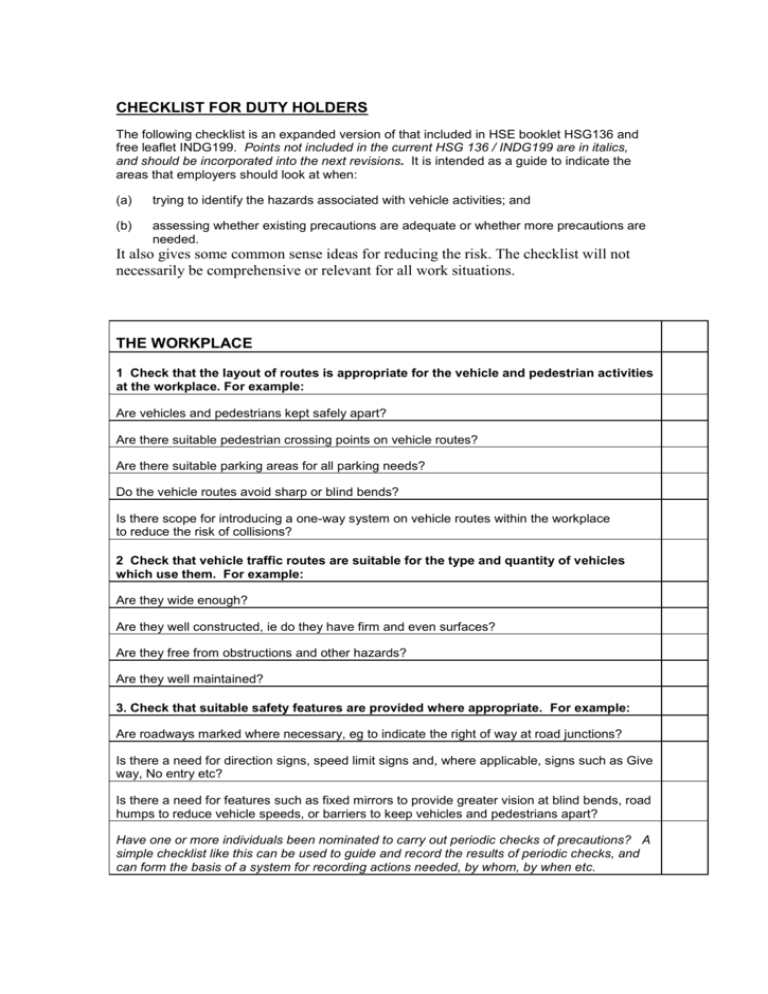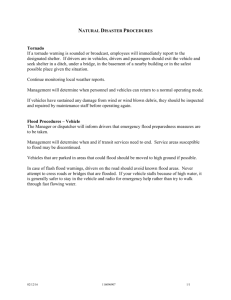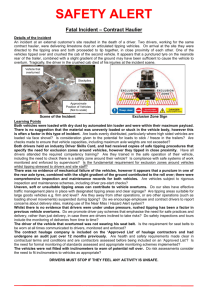HSE Aide Memoire – Transport Checklist
advertisement

CHECKLIST FOR DUTY HOLDERS The following checklist is an expanded version of that included in HSE booklet HSG136 and free leaflet INDG199. Points not included in the current HSG 136 / INDG199 are in italics, and should be incorporated into the next revisions. It is intended as a guide to indicate the areas that employers should look at when: (a) trying to identify the hazards associated with vehicle activities; and (b) assessing whether existing precautions are adequate or whether more precautions are needed. It also gives some common sense ideas for reducing the risk. The checklist will not necessarily be comprehensive or relevant for all work situations. THE WORKPLACE 1 Check that the layout of routes is appropriate for the vehicle and pedestrian activities at the workplace. For example: Are vehicles and pedestrians kept safely apart? Are there suitable pedestrian crossing points on vehicle routes? Are there suitable parking areas for all parking needs? Do the vehicle routes avoid sharp or blind bends? Is there scope for introducing a one-way system on vehicle routes within the workplace to reduce the risk of collisions? 2 Check that vehicle traffic routes are suitable for the type and quantity of vehicles which use them. For example: Are they wide enough? Are they well constructed, ie do they have firm and even surfaces? Are they free from obstructions and other hazards? Are they well maintained? 3. Check that suitable safety features are provided where appropriate. For example: Are roadways marked where necessary, eg to indicate the right of way at road junctions? Is there a need for direction signs, speed limit signs and, where applicable, signs such as Give way, No entry etc? Is there a need for features such as fixed mirrors to provide greater vision at blind bends, road humps to reduce vehicle speeds, or barriers to keep vehicles and pedestrians apart? Have one or more individuals been nominated to carry out periodic checks of precautions? A simple checklist like this can be used to guide and record the results of periodic checks, and can form the basis of a system for recording actions needed, by whom, by when etc. THE VEHICLES 4 Check that vehicles are safe and suitable for the work for which they are being used. For example: Have a suitable vehicle and attachments been selected for the tasks which are actually undertaken? For instance, a side loader may be needed if very long articles frequently need to be carried, rather than using a general counterbalance truck for a task it is not really designed for. Do they have suitable and effective service and parking brakes? Do they have windscreens with wipers, and suitable external mirrors to provide optimum allround visibility? Are they provided with horns, lights, reflectors, reversing lights and other safety features as necessary? Do they have seats and, where necessary, seat belts that are safe and provides driver comfort? Are there guards on dangerous parts of the vehicles, eg power take-offs, chain drives, exposed exhaust pipes? Do drivers need protection against bad weather conditions, or against an unpleasant working environment, ie the cold, dirt, dust, fumes, and excessive noise and vibration? Is there a safe means of access to and exit from the cabs and other parts that need to be reached? Is there a need for driver protection against injury in the event of an overturn, and to prevent the driver being hit by falling objects? 5 Check that the vehicles are subject to appropriate maintenance procedures. For example: Do the drivers carry out basic safety checks before using vehicles? Is there a regular preventive maintenance programme for each vehicle, carried out at predetermined intervals of time or mileage? Where there is a need for thorough examination, is this taking place? DRIVERS AND OTHER EMPLOYEES 6 Check that your selection and training procedures ensure that your drivers and other employees are capable of performing their work activities safely and responsibly. For example: Do you check the previous experience of your drivers and test them to ensure they are competent? (NB for fork lift truck driving, see Approved Code of Practice) Do you provide training on how to perform the job, and information about particular hazards, speed limits, the appropriate parking and loading areas etc? Do you have a planned programme of refresher training for drivers and other employees to ensure their continued competence? 7 Check what your drivers and other employees actually do when undertaking their work activities. For example: Do your drivers drive with care, eg use the correct routes, drive within the speed limit and follow any other site rules? Do they park safely and in safe locations? Are your employees using safe working practices, eg when loading/unloading, securing loads, carrying out maintenance etc? Do your drivers and other employees have to rush to complete their work on time, or is there a risk of accidents caused by fatigue as a result of excessive working hours? Do managers routinely challenge and investigate unsafe behaviours they may come across? Do they set a good example, for instance by obeying vehicle / pedestrian segregation instructions, and by wearing high visibility garments where needed? 8 Check, in consultation with your employees, that your level of management control/supervision is suitable. For example: Are your supervisors, drivers and other employees, including contractors and visiting drivers, aware of the site rules and aware of their responsibilities in terms of maintaining a safe workplace and safe working practices? Is everyone at the workplace supervised and held accountable for their responsibilities, and is a clear system of penalties enforced when employees, contractors etc fail to maintain standards? Are adequate steps taken to detect any unsafe behaviour of drivers of site vehicles, visiting vehicles and pedestrians, to investigate any underlying reasons, and to correct unsafe behaviours? Have nominated individuals been made responsible for detecting, investigating and correcting unsafe behaviours? VEHICLE ACTIVITIES 9 Check that the need for REVERSING manoeuvres is kept to a minimum, and where reversing is necessary that it is undertaken safely and in safe areas. For example: Is there scope for introducing one-way systems on routes to reduce the need for reversing manoeuvres? Can you exclude non-essential personnel from areas where reversing is common? Is there a need to clearly identify and mark 'reversing areas' to be clear to both drivers and pedestrians? Is there a need for a signaller (banksman) to direct reversing vehicles? Can this be done safely? Are there external side-mounted and rear-view mirrors on the vehicles to provide optimum allround visibility? Is there a need for CCTV on the back of certain vehicles to eliminate or reduce blind spots during any unavoidable reversing? CCTV is now cheap, makes reversing safer and easier, and should save money by reducing costly damage incidents. Do the vehicles have reversing alarms? 10 Check that drivers take care when PARKING their vehicles, including their own private cars, and that they park in safe locations. For example: Do your drivers use the designated parking areas? Do they always ensure that their vehicles and trailers are braked and secured before leaving them parked? 11 Check that LOADING AND UNLOADING operations are carried out safely. For example: Are loading/unloading operations carried out in an area away from passing traffic, pedestrians and others not involved in the loading/unloading operation? Are people needlessly “steadying” the load? Is there a need for better liaison between the site occupier and duty holders who deliver or pick up goods? Are the load(s), the delivery vehicle(s) and the handling vehicle(s) compatible with each other? Safety arrangements for deliveries can often be agreed when orders are taken. Are loading/unloading activities carried out using safe systems of work on ground that is flat, firm and free from pot-holes? Are the vehicles braked and/or stabilised, as appropriate, to prevent unsafe movements during loading and unloading operations? Is loading/unloading carried out so that, as far as possible, the load is spread evenly to avoid the vehicle or trailer becoming unstable? Are checks made to ensure that loads are secured and arranged so that they cannot move about, eg slide forward if the driver has to brake suddenly, or slide off if the vehicle has to negotiate steep inclines? Are there checks to ensure that vehicles are not loaded beyond their capacity? Does anyone have to go onto the vehicle or load, putting them at risk of falling? If so, is it possible to eliminate the need for them to go into such positions? If it’s unavoidable, what further precautions can be taken to reduce fall risks? See also 13. 12Check that TIPPING operations are carried out safely. For example: Do visiting drivers report to the site manager for any relevant instructions prior to commencing tipping operations? Are non-essential personnel excluded from tipping areas? Are tipping operations undertaken on ground that is level and stable and at a location free from overhead hazards such as power lines, pipework etc? Where sites are not level and stable, are the tipping faces safe for vehicles involved in tipping operations, eg compacted and with no significant side slopes? Is there a need for suitably sized wheel-stops where vehicles need to reverse prior to tipping? Are tailgates released prior to tipping, and removed when necessary? Do drivers check that their loads are evenly distributed across the vehicle prior to commencing tipping operations? Are the drivers sufficiently experienced to anticipate loads sticking? Do drivers always ensure that the body is completely empty, and drive no more than a few metres forward to ensure the load is clear? 13Check that SHEETING AND UNSHEETING operations are carried out safely. For example: Are sheeting and un sheeting operations carried out in safe parts of the workplace, away from passing traffic and pedestrians and sheltered from strong winds and bad weather? Are the vehicles parked on level ground, with their parking brakes on and the ignition key removed? Are gloves, safety boots and, where necessary, eye and head protection provided, and used by those engaged in the sheeting/un sheeting operations? Is there scope for using proprietary sheeting systems to avoid the need for manual sheeting? Where manual sheeting is unavoidable, is there a system in place which avoids the need for a person to climb on the vehicle or load, ie by providing a platform from which loads can be sheeted? RISK CONTROL INDICATOR Assessment Scale Each risk control indicator should be assessed against the following 1 – 4 scale. A score of 1 must satisfy all the appropriate criteria of the risk control indicator. 3 4 1 2 Some compliance Limited or no Full compliance Broad in areas that compliance in areas that in areas that compliance in matter matter matter areas that matter WORKPLACE TRANSPORT a) Safe Site Well defined traffic routes free from obstruction, firm and even surfaces. Every effort made to separate pedestrians from vehicles. Pedestrians crossing points. Effective one way system for HGVs b) Safe Vehicle Effective maintenance of steering, brakes and lights. ROPs and seat belts fitted when appropriate. Reversing aids fitted when appropriate. c) Safe Driver Fork lift truck drivers trained and competent in accordance with ACoP, similar for other types of vehicles. Active supervision of driver behaviour.






